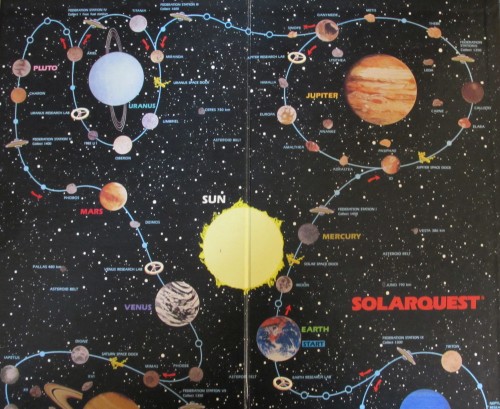By Margaret Harris
Last night, in honour of the New Horizons mission to Pluto, I pulled out my copy of Solarquest. This classic board game was a childhood favourite of mine, and it’s basically Monopoly in space: instead of buying properties named after streets in Atlantic City, New Jersey (or London, if you’re British), you buy planets, moons and artificial satellites. Then, when your fellow players land on an object you own, you charge them rent.
Such nostalgia is all well and good, I hear you say, but what’s it got to do with New Horizons or Pluto? Well, Solarquest’s inventors clearly took their science seriously. By board game standards, there’s quite a lot of physics in it. For example, you can’t leave a planet unless you roll a number high enough to overcome its gravitational pull, and its Monopoly-like property deed cards include facts about each planet and moon as well as their prices.
Solarquest, however, was invented in 1985, and it just so happens that 1985 marked an important milestone in our understanding of Pluto. In February of that year Pluto’s largest moon, Charon, passed in front of it from the perspective of Earth-bound observers. This transit, and others that followed, meant that for the first time astronomers could make a decent estimate of Pluto’s diameter, based on changes in its brightness during the transits.
The game, therefore, gives us a glimpse of what was known about Pluto at a crucial point in its history, when it was just beginning to be possible to study this icy world in detail. By extension, then, Solarquest also helps us appreciate how much more we know about Pluto now, thanks to New Horizons.
So what does Pluto look like in Solarquest? Well, for starters, it’s a planet: it says so right on the deed card. If you flip the deed card over, you’ll also find incorrect values for Pluto’s diameter, mean distance from the Sun, orbital period and inclination. The game, for example, sets Pluto’s diameter at 3000 km – a suspiciously round number that is about 25% too high, according to the latest New Horizons measurements. Such mistakes are excusable, given how little we knew about Pluto 30 years ago. But they are still mistakes. We know better now.
Looking at the Solarquest board, we can see that the game also erred in its depiction of Pluto’s moons. In 1985 we knew about only one of them: Charon, which was discovered in 1978. Since then, four smaller bodies – Nix, Hydra, Kerberos and Styx – have also been found orbiting Pluto. And thanks to New Horizons, we should have some good images of Nix soon. Let that sink in for a moment: a human-built spacecraft is now flying past a moon that 30 years ago (in fact, even just over 10 years ago) we didn’t know existed.
Solarquest’s inventors did get some things right about Pluto. In the game, as in real life, Pluto is pinkish in colour – something that surprised many when New Horizons began sending back colour images. And sadly, Solarquest was also right about Pluto not having any human-made satellites. That’s because the New Horizons spacecraft isn’t an orbiter: it will never again come as close to Pluto as it did last night. Instead, it will continue its journey to the outer reaches of the Kuiper belt and whatever awaits it there – leaving us here on Earth to wonder whether our understanding of the solar system will ever again change as much as it has this week.


Nice commentary on a game which tried very hard to get its science right, while still providing non-boring gameplay However, the Whiggish history is counterproductive.
However, the Whiggish history is counterproductive.
Everything you described says that Solarquest used the best available information for its time (+/-10% on the diameter is a perfectly acceptable astronomical measurment!). Complaining that they didn’t include non-existent information seems to ignore the nature of reality.
Trackback: Blog - physicsworld.com